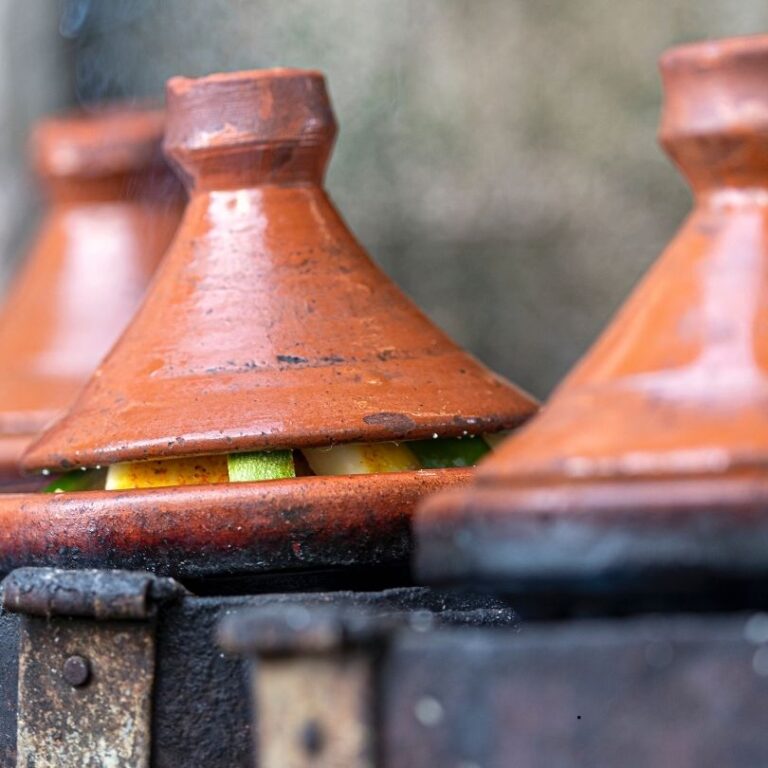
Tagine

When it comes to Moroccan cuisine, few dishes are as iconic and beloved as Tagine. This slow-cooked, flavorful dish gets its name from the traditional clay pot in which it’s cooked, and it’s a cornerstone of Moroccan street food culture. Whether you’re wandering through the bustling markets of Marrakech or visiting a small village, Tagine is a staple on the street food scene. With its aromatic spices, tender meats, and hearty vegetables, Tagine offers a delicious and authentic taste of Morocco that’s not to be missed.

The History of Tagine
Tagine’s roots can be traced back centuries, to the time of the Berbers, the indigenous people of North Africa. The dish originally emerged as a practical and flavorful way to cook ingredients slowly over a low fire, preserving both nutrients and flavor. The distinctive cone-shaped Tagine pot allows steam to circulate within, ensuring that the food stays moist and tender while locking in all the delicious spices and aromas.
Over the years, Tagine has evolved to include a variety of ingredients, from meats like chicken and lamb to vegetables, fruits, and legumes. The dish’s popularity spread across Morocco and beyond, becoming a culinary symbol of Moroccan hospitality and tradition. Whether served at a family gathering or dished out on a bustling street corner, Tagine reflects Morocco’s rich history, blending Arab, Berber, and Andalusian influences into a truly unique dish.
What Makes a Tagine So Special?
The magic of Tagine lies in its slow cooking process, which allows flavours to develop and mingle in a way that creates a depth of taste that’s both complex and comforting. A typical Tagine consists of meat, vegetables, dried fruits like apricots or prunes, and a fragrant blend of spices. The use of spices like cumin, coriander, cinnamon, ginger, turmeric, and saffron is a hallmark of Moroccan cuisine, giving Tagine its distinct warm and aromatic flavour profile.
The Tagine pot itself plays a crucial role in cooking the dish. The conical lid traps steam as the dish simmers, condensing moisture and redistributing it back into the food, ensuring that it stays juicy and tender. Whether cooked over hot coals in a street market or in a home kitchen, the result is always the same: melt-in-your-mouth tenderness and a burst of rich, vibrant flavors in every bite.
Tagine can be made with a variety of proteins, including lamb, chicken, beef, or fish, and the addition of vegetables like carrots, potatoes, and zucchini makes it a complete, hearty meal. The dish is often served with khobz, traditional Moroccan bread, which is perfect for scooping up the delicious, saucy goodness.
Where to Find the Best Tagine in Morocco
While Tagine is commonly served in Moroccan restaurants, some of the best versions of this dish can be found on the streets, where vendors cook it in large clay pots over open flames.
Marrakech: The vibrant Jemaa el-Fnaa square in Marrakech is one of the best places to sample Tagine. As the sun sets, the square comes alive with food stalls, and the aroma of spices fills the air. Vendors here serve a variety of Tagines, including popular versions like chicken with preserved lemon and olives, or lamb with prunes and almonds.
Fez: Fez is known for its rich culinary traditions, and the street food scene is no exception. In the city’s medina, you can find small stalls offering delicious Tagines that are cooked slowly in the traditional way. The Tagines here are often heartier, with generous portions of vegetables and perfectly spiced meats.
Essaouira: For seafood lovers, the coastal town of Essaouira is the perfect place to try a seafood Tagine. Made with fresh fish, tomatoes, and herbs, this version of Tagine is light yet bursting with flavour. Served right by the sea, it’s a unique and memorable experience.
Chefchaouen: The famous blue city of Chefchaouen offers a more laid-back setting to enjoy Tagine. Here, you can find restaurants and street vendors offering both traditional meat Tagines and vegetarian options, making it a great stop for anyone looking to try different variations of the dish.
tagine
We may receive compensation from partners listed through affiliate partnerships, at no cost to you. This doesn’t influence our ratings, and the opinions are our own
QUICK LINKS
- Blogs
- Privacy Policy
Join our Newsletter
Get the latest recipes, trends and travel ideas
